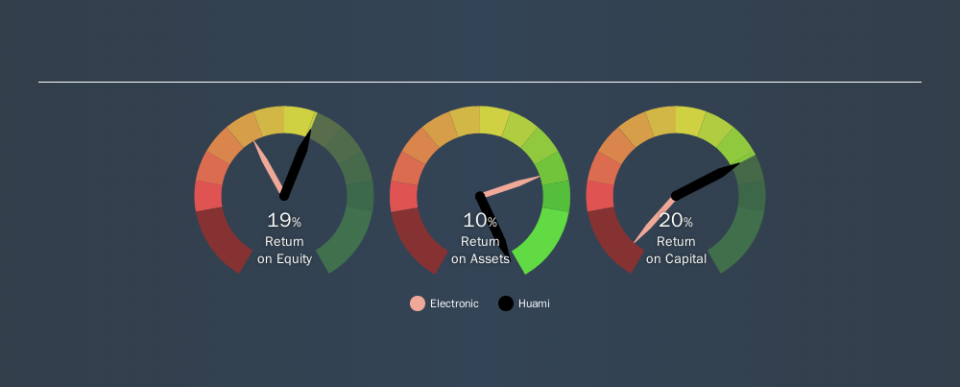Should You Like Huami Corporation’s (NYSE:HMI) High Return On Capital Employed?

Today we are going to look at Huami Corporation (NYSE:HMI) to see whether it might be an attractive investment prospect. Specifically, we'll consider its Return On Capital Employed (ROCE), since that will give us an insight into how efficiently the business can generate profits from the capital it requires.
First of all, we'll work out how to calculate ROCE. Second, we'll look at its ROCE compared to similar companies. Finally, we'll look at how its current liabilities affect its ROCE.
What is Return On Capital Employed (ROCE)?
ROCE is a metric for evaluating how much pre-tax income (in percentage terms) a company earns on the capital invested in its business. Generally speaking a higher ROCE is better. Overall, it is a valuable metric that has its flaws. Renowned investment researcher Michael Mauboussin has suggested that a high ROCE can indicate that 'one dollar invested in the company generates value of more than one dollar'.
How Do You Calculate Return On Capital Employed?
The formula for calculating the return on capital employed is:
Return on Capital Employed = Earnings Before Interest and Tax (EBIT) ÷ (Total Assets - Current Liabilities)
Or for Huami:
0.20 = CN¥428m ÷ (CN¥3.6b - CN¥1.4b) (Based on the trailing twelve months to June 2019.)
Therefore, Huami has an ROCE of 20%.
Check out our latest analysis for Huami
Is Huami's ROCE Good?
When making comparisons between similar businesses, investors may find ROCE useful. Huami's ROCE appears to be substantially greater than the 12% average in the Electronic industry. We consider this a positive sign, because it suggests it uses capital more efficiently than similar companies. Separate from Huami's performance relative to its industry, its ROCE in absolute terms looks satisfactory, and it may be worth researching in more depth.
Huami has an ROCE of 20%, but it didn't have an ROCE 3 years ago, since it was unprofitable. This makes us wonder if the company is improving. The image below shows how Huami's ROCE compares to its industry, and you can click it to see more detail on its past growth.
When considering this metric, keep in mind that it is backwards looking, and not necessarily predictive. ROCE can be misleading for companies in cyclical industries, with returns looking impressive during the boom times, but very weak during the busts. ROCE is, after all, simply a snap shot of a single year. Since the future is so important for investors, you should check out our free report on analyst forecasts for Huami.
What Are Current Liabilities, And How Do They Affect Huami's ROCE?
Liabilities, such as supplier bills and bank overdrafts, are referred to as current liabilities if they need to be paid within 12 months. Due to the way the ROCE equation works, having large bills due in the near term can make it look as though a company has less capital employed, and thus a higher ROCE than usual. To check the impact of this, we calculate if a company has high current liabilities relative to its total assets.
Huami has total assets of CN¥3.6b and current liabilities of CN¥1.4b. Therefore its current liabilities are equivalent to approximately 38% of its total assets. Huami has a medium level of current liabilities, which would boost the ROCE.
The Bottom Line On Huami's ROCE
Huami's ROCE does look good, but the level of current liabilities also contribute to that. There might be better investments than Huami out there, but you will have to work hard to find them . These promising businesses with rapidly growing earnings might be right up your alley.
I will like Huami better if I see some big insider buys. While we wait, check out this free list of growing companies with considerable, recent, insider buying.
We aim to bring you long-term focused research analysis driven by fundamental data. Note that our analysis may not factor in the latest price-sensitive company announcements or qualitative material.
If you spot an error that warrants correction, please contact the editor at editorial-team@simplywallst.com. This article by Simply Wall St is general in nature. It does not constitute a recommendation to buy or sell any stock, and does not take account of your objectives, or your financial situation. Simply Wall St has no position in the stocks mentioned. Thank you for reading.

